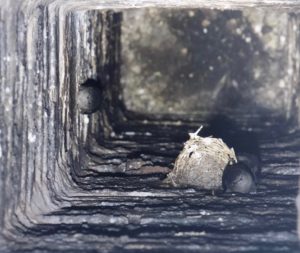by Nancy Nabak, Communications Coordinator
I can’t wait. Any day now the high-pitched chittering sounds of Chimney Swifts will be heard here again as they return from their winter homes in South America. They are such cool birds, and I’ve developed a crush on them that favors above most of my other bird crushes.
I think one of the main reasons that I like this bird so much is because of its tenacious spirit – spitting in the face of habitat loss. Initially, Chimney Swifts nested in the hollows of old growth forest snags. As we pioneered and clear-cut our way across the country while settling, their forest habitat was lost. But this clever bird species found a way to adapt to new habitat – the chimneys that were being built. Thus, the name Chimney Swift (originally, Audubon called them American Swifts).
They are small, unique birds, about swallow-sized, with a rapid and erratic flight pattern. Their short, tapered tails and curve-shaped wings make them look like flying cigars. But I think their most unique attribute is that while migrating, large numbers of swifts, even into the thousands, can be found in the early evenings entering uncapped brick chimneys to roost for the night.
As I said, I can’t wait for their return. We are lucky enough to have swifts nesting in our chimney here at Woodland Dunes. Even better, my desk is near the chimney, so I can hear them chittering while they’re nest-building and feeding their young during the day. It’s an audible treat to witness while I work behind my desk.
We’re doing all we can to help this species because in the last 50 years, it has experienced a 50% decline in its population. One way is by planting native species this spring, which also helps address the declining insect population issue. These plants attract pollinators and other flying insects that swifts love to feast on.
We are also creating new partnerships including the newly launched Wisconsin-based campaign, SOS Save Our Songbirds. Together, we are advocating for homeowners and rental property owners with green space to join in the native planting campaign. For example, coneflowers are a colorful and easy native plant to grow which attracts hummingbirds, butterflies, bees and other flying insects – producing a healthy food source for Chimney Swifts. The great thing here is, when you address one issue, you’re also taking care of another.
We’re also working with Minnesota biologists who are launching a Chimney Swift migration project. This project will put transmitter tags on our nesting swifts to learn their migration routes and target key conservation efforts.
Keep your eyes and ears open for this amazing bird’s return. Its chitter becomes music to your ears and its acrobatic flight a delight to watch. Just knowing this clever bird is out there to enjoy is both exciting and calming. Please, let’s do all we can to make sure we have many days and evenings of splendor with this bird as our entertainer.

